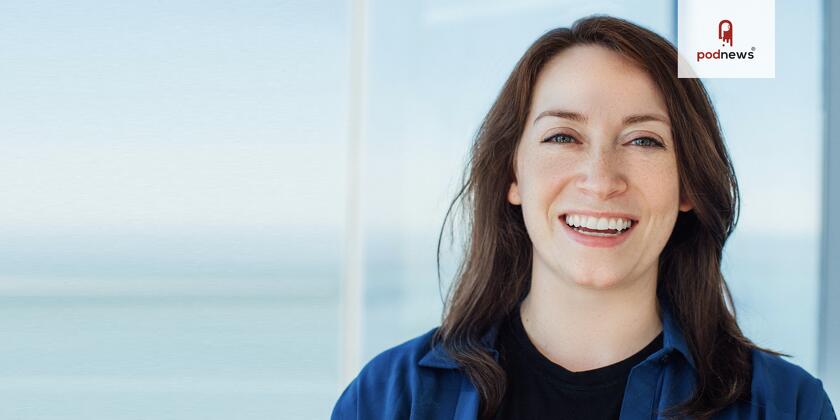
Questions to... Spotify's Maya Prohovnik

This article is at least a year old
Maya Prohovnik is VP of Podcast Product at Spotify, and oversees the teams who are responsible for building tools and features for podcasters and podcast listeners. She was employee #1 at Anchor. Podnews interviewed Maya over email; and, since she’s a podcaster herself, asked her to record a few answers in audio. The transcript has been edited for clarity.
So, first, what is a podcast?
I love this question. This is something that I’ve thought about a lot over the years. I was the first employee at Anchor back in the day — I stayed with the company through our sale to Spotify and now I lead product for Spotify’s podcast team. So I’ve been through a lot of evolutions of podcasts over the years. Where I’ve landed is, I think it’s less about the delivery mechanism or whether it’s audio or video, it’s also really not up to me or any person or company to define. I think a podcast is whatever podcast creators and listeners say it is, and they’re telling us more and more that to them, a podcast can be video, it can be interactive, it can exist outside of an RSS feed. And since all of those things introduce new, great opportunities for podcasters, I don’t see why we wouldn’t lean into them as an industry.
At its core, the things that attract people to podcasts as a medium have remained the same, even as all of these other things have been evolving. It’s about information connection, great storytelling. And I don’t really see that changing despite whatever continues to happen with the format itself.
Why has Spotify been so successful as a way of listening to podcasts?
I think there are a few reasons why people love listening to podcasts on Spotify.
First, our UX is built to be intuitive and user-friendly, and Spotify works great on nearly every device (even smart fridges!) — so you can truly listen wherever you are.
Next, people like having all of their audio content on a singular platform. Spotify has become part of peoples’ listening routines, and we can uniquely make listening recommendations across formats — so for example, we know what audiobooks you might like based on your podcast listening preferences.
Which leads me to my last point: just how well we do personalization and discovery. Podcast fans are always looking for their next favorite show. At a platform level, we’ve spent years investing in our recommendation products and algorithms — plus we have an incredible editorial team that helps curate our recommendation shelves to reflect real-time, cultural moments. We have this motto internally that’s basically “one product; 600 million different experiences” and I think that speaks well to our overall approach that consumers love.
Spotify has a real focus on video these days. How important is video to podcasters?
Well, this is certainly the question of the hour. I’ll start by saying that Spotify will obviously always be an audio-first platform just like, we’ll always be a music-first platform.
But you’re right that we are very focused on video for podcasters. The data we have strongly suggests that at this point including video in your show helps you find an audience faster. We just put out our annual Fan Study this week which has a bunch of new data on video podcast performance — it showed that more podcast consumers are choosing video over audio, they stick around longer with video versus audio-only episodes, and they increasingly expect to be able to choose between watching or listening when they’re consuming a podcast. And we’re seeing this all around the world.
This is why we’ve worked really hard to make it easy for all Spotify users, whether or not they’re paying for Spotify Premium, to find video podcasts and to switch seamlessly between watching and listening. We know that’s important to people and helps them get more comfortable with video as a part of their podcast experience.
That said, I am a podcaster, and I know firsthand that it will not make sense for every audio show to make the jump to video. I don’t think, you know, for example, anyone wants or needs to watch me talk about the Big Brother Reality TV show in video form. And it’s certainly not worth the extra production effort for me to invest in video there. But for one of my other shows that I do spend more time on, it’s a little bit higher production value, we’ve just started doing video instead of audio. And I was pleasantly surprised by how natural it felt, and how positively my audience responded to having the video option.
My advice to everyone is always to go with the format that works best for you and your show — that goes for audio or video. But I will say that I think video is definitely worth considering because it really can improve your ability to find new audiences and help deepen people’s connection to you and your show.
Transcripts are important - creator-produced transcripts are in RSS feeds from a number of podcast hosts, and supported by Pocket Casts, AntennaPod, PodcastAddict and Apple Podcasts (who use creator-produced transcripts where they exist). When will Spotify support creator-produced transcripts?
Thanks for asking this — I know this is a feature that’s top of mind for a lot of podcasters out there, so I’m glad to have the chance to address this. While I can’t share specifics with you today, I can tell you that we are very actively working on expanding our transcripts capabilities, including both expanding availability and performance of Spotify-provided transcripts and building support for creators to customize their transcripts, and I hope to have an update for you very soon.
How important is open RSS to Spotify and how will you continue supporting it?
One of the main benefits of podcasting has always been that creators can really easily distribute their content to multiple platforms and consumers have the choice of where and how they want to listen to it. And I think the benefits of wide distribution for creators in particular are more apparent than ever. You’ve seen this reflected in the Spotify strategy with shows like Joe Rogan and Science Vs. going back to being available everywhere.
We understand that RSS plays an important role in giving creators more control over their content, and we plan to continue supporting both on and off-platform distribution for shows that are hosted with Spotify as well as allowing podcasters to keep distributing their content to Spotify from other hosts over RSS. Nothing is changing there.
That said, we do have more tools and functionality on Spotify that go beyond what RSS supports. For us, that’s not about exclusivity — we want to be able to keep innovating on the format and opening up new avenues for fans and creators to connect with each other, for creators to have options about how to monetize, how to express themselves and customize their show. So we will keep doing that. As you’ve noted — and hopefully most of your audience have noticed throughout this year — we’re going to continue to invest in the open ecosystem as much as we can. It’s a really big priority for me to make sure that all podcasters can get the most possible value out of Spotify. So whether it’s through RSS or through our own tools, either way, that’s always our goal: helping podcasters get the most out of our platform.
What is Spotify focusing on next for podcasting?
I’m going to answer this through a product lens since that’s my wheelhouse: we have a lot in store for this fall.
We’re really invested in making Spotify the best platform for all types of creators to connect with their biggest fans, and in giving creators more control over building their communities, so you’ll see enhancements to some of our core interactivity and audience engagement capabilities. We’re building more opportunities for podcast creators to merchandise and monetize their shows. And we’re continuing to invest in improving our video capabilities, both for creators and consumers (we have more than 250,000 video shows on platform and will continue to make it easier and more streamlined for creators to experiment with and embrace the format).
Longer-term, I continue to believe that there is still a lot of potential to improve podcast discovery. This is something Spotify is already great at for music: recommending the right piece of content at exactly the right time, and being able to help someone find the right thing to match their current mood. I’m excited to keep working on this for podcasts.
What podcasts do you listen to?
I’m a huge fan of music deep dives (so I’m really the perfect customer for Spotify podcast recommendations…); I never miss an episode of Every Single Album or Song Exploder.
I’m also really into Search Engine, I love Acquired’s episodes when I’m on a long car ride, and my husband listens obsessively to old episodes of Car Talk so I’ve become an accidental superfan of that one too, even though I don’t really care about cars. The power of podcasting!
What’s the best way to give you and your team feedback?
First of all, PLEASE do send us feedback – my team and I love hearing from you and being able to help solve your problems. And we often prioritize building features based directly on these requests. Let us know what could be even better — whether you have feedback about our tools for podcasters and publishers, or the Spotify podcast discovery/listening experience. You’re welcome to reach out to me on social media (I’m @mayafish on most platforms), or you can always get in touch with our great team at @spotifyforpodcasters.
































































































